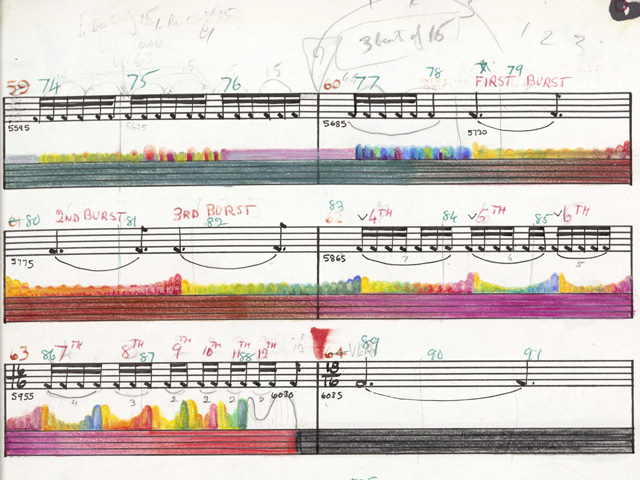 Most Canadians of a certain age will remember seeing, at some point, the work of National Film Board auteur Norman McLaren. Most will remember the nouveau-operatic stylings of 1952’s Neighbours, its silent protagonists flickering in and out of existence as just one part of its enchanting stop-motion scenery and the most recognizable example of his pixilation video technique. And yes, the synthesized score’s pointillism punctuates with precision – but what if I told you this score was created by hand, and moreover, an analog synthesizer had nothing to do with it?
Most Canadians of a certain age will remember seeing, at some point, the work of National Film Board auteur Norman McLaren. Most will remember the nouveau-operatic stylings of 1952’s Neighbours, its silent protagonists flickering in and out of existence as just one part of its enchanting stop-motion scenery and the most recognizable example of his pixilation video technique. And yes, the synthesized score’s pointillism punctuates with precision – but what if I told you this score was created by hand, and moreover, an analog synthesizer had nothing to do with it?
Bear with me if you’re already in the know, but it turns out that McLaren developed a technique over a period of decades wherein he quite literally drew on the area of optical tape reserved for the sound track in order to directly compose and perform most of his films’ scores. By creating various etches read at the right frequency, in perfect synchronization with the film reel, McLaren was one of the first to create a synthesized film score of any kind, and was uniquely original in the way he continued to refine this technique over the course of decades. Sound tests, never before seen in a public screening, were presented at part of a short documentary directed by Don McWilliams and receiving its Canadian premiere at the 2014 Ottawa International Animation Festival.
This year is the centenary of McLaren’s birth. McWilliams, who previously directed a more broad-ranging documentary on McLaren in the early 90s (shortly after McLaren’s death in 1987), had set up an installation recently in Sterling, Scotland, the town of McLaren’s birth. Unfortunately, it wasn’t the project fell through when arts funding was cut in Scotland. The National Film Board, bless their hearts, subsequently suggested McWilliams create a half hour documentary focusing on Norman’s experimentation with sound.
McLaren was first set on his experimentation in the 1930s, when he had a synesthetic experience while listening to European radio in the 1930s. He had studied violin and piano for a year, read Paul Hindemith, and became, in his words, a “half-baked composer.” Well, it turns out some music is quite delicious when it’s “half-baked.”
His discovery of handcrafted synthesis happened in 1937. “Like any other sound, it has its own pattern of light and dark,” he remarked. He played these hand-drawn sounds on the moviola. Using the brush, he drew a row of small triangles – and was eventually able to play entire major scales, by spacing his marks at evenly spaced heights (and ergo, frequencies). He would expand the palette by scratching marks out of a black band, using a variety of tools such a knives, styli, and razor blades in the pursuit of a carefully plotted distribution of sound. Further, aleatoric reverberation was mixed in, in an effort to stray from cold precision. “I think a so-called abstract film can have human feelings,” McLaren rightly suggested, noting our even the most abstract sounds and visuals can behave in a most human or animal way, evoking that which is human – or animal – in a person.
McLaren would converse and collaborate with many of his composer contemporaries, including Eldon Rathburn, Maurice Blackburn, Béla Bartók, Milton Babbit (who noted McLaren’s was “the only true electronic music before the synthesizer”) and John Cage, among others. These resulted in experiments such as microtonal sound tracks. Under Cage’s suggestion, McLaren used various radiating lines to achieve a microtonal effect, culminating in his Microtonal Improvisation test in March 1951. However, his favourite tone was the sharp, sawtooth wave tone his developed, which presented a multitude of harmonic, rhythmic, and textural possibilities, for example juxtaposed against an orchestral recording in 1953’s “Narcissus.” These experiments arguably reached their climactic point in 1971’s “Synchromy,” wherein “the eye hears; the ear sees.” I am convinced there is a rich history still waiting to be unearthed regarding McLaren’s musical relations.
McWilliams and Luigi Allemano, a professor of film and an electroacoustic composer from Concordia University, were on hand to emcee and host a brief question and answer session afterwards. I pressed further about McLaren’s relationships with other composers, to which Allemano noted:
“Norman McLaren was completely underrated as a musician, and his technical innovation wasn’t properly recognized. One can be a musician-animator. It was quite interesting and exceptional. Don was doing some stereoscopic restorations, which have since been screened. This aspect of his work had to be put out there. There hasn’t been anything equivalent since – working through picture and sound o a frame-by-frame basis, simply through drawings. Harmonically, McLaren was conservative, but rhythmically he was at quite a high level, perhaps due in part to his interest in raga and the work of Ravi Shankar.”
Today, you can try these techniques for yourself in a simulated manner, as part of the McLaren’s Workshop iPad app. Over 3000 films have been made by Scottish schoolchildren in this manner as part of the 2014 McLaren celebration in Scotland.
A general release date for Norman McLaren: Animated Musician hasn’t been set as of this writing, but be sure to keep an ear out for this one. You can learn much more about McLaren, and the celebrations surrounding the centenary of McLaren’s birth, at mclaren2014.com.
https://www.youtube.com/watch?v=0yJRWUAKgnY
- LINES OF ENQUIRY | Indie-Classical, For All its Boundary-Shifting, Is Another Boys Club - December 2, 2014
- LINES OF ENQUIRY | To Hell and Back: Canadian Premiere of Piano-Four-Hands Arrangement of Liszt’s Dante Symphony Timely, Poignant - October 30, 2014
- LINES OF ENQUIRY | The Future of Notation Software - October 22, 2014




